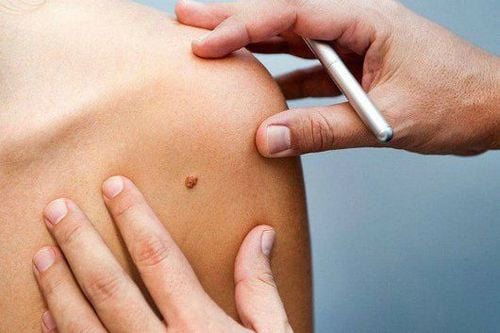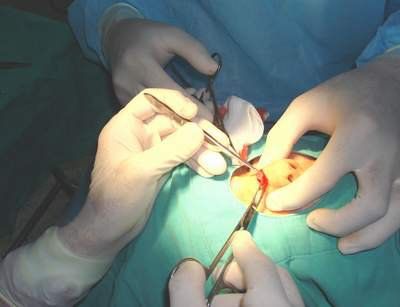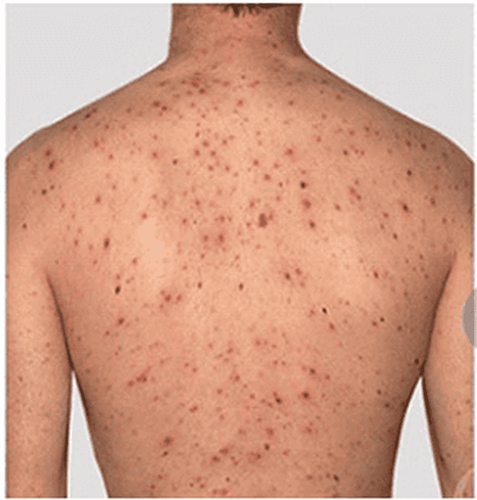This is an automatically translated article.
Basal cell carcinoma is a malignant tumor that originates in the cells in the basal layer of the epidermis. Diagnosis of basal cell carcinoma is based on clinical symptoms and histopathological examination.1. What is basal cell carcinoma?
Basal cell carcinoma (BCC) is a common type of skin cancer, accounting for about 75% of all skin cancers. Basal cell skin cancer originates in the basal cells - a type of cell in the skin that forms the deepest layer of the epithelium. These new skin cells will gradually replace the old cells as they die.Basal cell carcinoma usually appears as a raised, slightly transparent bump on the skin. In addition, the disease can manifest lesions in other forms. Basal cell skin cancer most often occurs on sun-exposed areas of skin, such as the head and neck.
Most patients with basal cell carcinoma are caused by long-term exposure to ultraviolet (UV) rays from sunlight. Avoiding the sun and using sunscreen are effective measures to prevent the disease.
Trắc nghiệm: Thử hiểu biết của bạn về bệnh ung thư
Ung thư là nguyên nhân gây tử vong hàng thứ 2 trên thế giới. Thử sức cùng bài trắc nghiệm sau đây sẽ giúp bạn có thêm kiến thức về yếu tố nguy cơ cũng như cách phòng ngừa bệnh ung thư.
Bài dịch từ: webmd.com
2. Diagnosis of basal cell carcinoma

To evaluate for any lumps or unusual changes in your skin, your doctor or dermatologist will perform an exam and make a diagnosis.
2.1. Medical history The doctor will perform a general examination and ask the patient a number of questions about medical history, unusual skin changes, or any other signs and symptoms.
Questions about medical history include:
When did you first notice the appearance of this tumor or skin lesion? Do your symptoms seem to have changed since you first noticed them? Do lumps or lesions on the skin cause pain? Have you noticed any lumps or other lesions on your body? Have you had skin cancer before? Has anyone in your family had skin cancer and what type of cancer? How often do you take precautions to keep your skin safe from the sun, such as using sunscreen and avoiding midday sun? Do you check the condition of your skin periodically? 2.2. Skin examination The doctor will examine not only the area where basal cell carcinoma is suspected, but also other places on the patient's body to look for other lesions.
2.3. Skin biopsy A skin biopsy is a procedure in which a small sample of a lesion is removed and tested in a laboratory. This will show whether the patient has skin cancer and if so, what type of skin cancer it is. The type of skin biopsy needed depends on the type and size of the lesion.
3. Basal cell skin cancer treatment

The goal of treatment for basal cell carcinoma is to completely remove the cancer. Choosing the most appropriate treatment for you depends on the type, location, and size of the cancerous tumor, as well as your desire and ability to return for treatment. The decision to treat may also depend on whether this is basal cell carcinoma first detected or has recurred. Some of the main options include:
3.1. Surgery Basal cell carcinoma is usually treated with surgery, which removes all of the cancer cells and the tissue around them.
Surgical options may include:
Surgical excision : The doctor removes the cancerous skin tissue and the surrounding margin. The margin is examined under a microscope to make sure there are no cancer cells. This approach is recommended for basal cell carcinomas that are less likely to recur, such as those who present with symptoms on the chest, back, arms and legs; Mohs surgery: The doctor removes the cancerous skin layer by layer under the help of a microscope until no more abnormal cells are detected. This allows the surgeon to remove all of the malignant cells, while avoiding removing too much of the surrounding healthy skin cells. Mohs surgery is recommended if patients with basal cell carcinoma are at high risk of recurrence, such as if the tumor tends to become larger, penetrates deeper into the skin, or is located on the patient's face. 3.2. Other treatments Sometimes, other treatments may be recommended in certain situations, such as when a patient is unable to have surgery or is unwilling to have surgery.
Other treatments include:
Scaling and electrophoresis : Removing the surface of the skin cancer with a scraper, then controlling the cancer cells with an electric needle. This approach is often chosen for the treatment of small basal cell carcinomas that are less likely to recur, such as patients who present with symptoms in the back, chest, arms, and legs; Radiation therapy: Using high-energy beams, such as X-rays and a stream of protons, to kill cancer cells. Radiation therapy is sometimes used after surgery if the patient is at high risk of the cancer coming back; Freezing: Freezing cancer cells with liquid nitrogen under low temperature conditions. This is an option for treating superficial skin lesions. Cryosurgery can be performed after the surface of the skin cancer has been removed with a scraper and is commonly used in the treatment of small and thin basal cell carcinomas, when surgery is not required. is an appropriate choice; Topical treatment: Cream or ointment (prescription) may be considered for the treatment of small and thin basal cell carcinoma if the patient cannot have surgery; Photodynamic therapy : Treatment of superficial skin cancer by applying energy from light and contrast agent . In photodynamic therapy, doctors use a liquid drug that makes cancer cells sensitive to light. Then, a light source is shined on and destroys the skin cancer cells. 3.3. Treatment of cancer that has spread In rare cases, basal cell carcinoma can spread to nearby lymph nodes and other areas of the body (called metastasis). Additional treatment options in this situation include:
Targeted drug therapy: A drug treatment that targets specific weak points of cancer cells. By interfering with these weaknesses, targeted drug treatments can cause cancer cells to die, while preserving the integrity of normal cells. Targeted drugs for basal cell carcinoma block cancer growth signals, preventing them from continuing to grow. This approach may be considered after other treatments or when other options are not available; Chemotherapy: Chemotherapy uses a treatment regimen with powerful drugs to completely destroy cancer cells. This is an option when other treatments have not worked. In order to serve the diagnosis and treatment of basal cell carcinoma, patients should pay attention to keep the personal and family medical history information, including the drugs that have been and are being used. .
Vinmec International General Hospital is one of the hospitals that not only ensures professional quality with a team of leading medical professionals, modern equipment and technology, but also stands out for its examination and consultation services. comprehensive and professional medical consultation and treatment; civilized, polite, safe and sterile medical examination and treatment space.
Please dial HOTLINE for more information or register for an appointment HERE. Download MyVinmec app to make appointments faster and to manage your bookings easily.
Articles refer to the source: mayoclinic.org
MORE:
Learn skin biopsy techniques Basal cell carcinoma: Causes, symptoms, diagnosis and treatment What are contrast agents?













